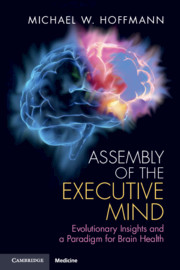Book contents
- Assembly of the Executive Mind
- Assembly of the Executive Mind
- Copyright page
- Dedication
- Contents
- Acknowledgments
- Introduction
- Chapter 1 The Evolution of Larger Brains since the Vertebrate–Invertebrate Divide
- Chapter 2 The Profound Increase in Primate Gray Matter Growth
- Chapter 3 Exponential White Matter Growth and Major Fiber Tract Systems Assembly
- Chapter 4 Cellular and Molecular Changes
- Chapter 5 The Core Frontal Systems
- Chapter 6 Enhanced Working Memory
- Chapter 7 Unraveling of Brain Networks in Neurological Conditions
- Chapter 8 Neurological Diseases as Networktopathies with Disconnection Phenomena
- Chapter 9 The Sensitivity and Vulnerability of the Prefrontal Cortex to Changes in Daily Rhythms
- Chapter 10 Implications for Treatment and Management
- Chapter 11 Sense of Self Disorders
- Chapter 12 Implications for You and Society
- Index
- References
Chapter 9 - The Sensitivity and Vulnerability of the Prefrontal Cortex to Changes in Daily Rhythms
Published online by Cambridge University Press: 05 January 2019
- Assembly of the Executive Mind
- Assembly of the Executive Mind
- Copyright page
- Dedication
- Contents
- Acknowledgments
- Introduction
- Chapter 1 The Evolution of Larger Brains since the Vertebrate–Invertebrate Divide
- Chapter 2 The Profound Increase in Primate Gray Matter Growth
- Chapter 3 Exponential White Matter Growth and Major Fiber Tract Systems Assembly
- Chapter 4 Cellular and Molecular Changes
- Chapter 5 The Core Frontal Systems
- Chapter 6 Enhanced Working Memory
- Chapter 7 Unraveling of Brain Networks in Neurological Conditions
- Chapter 8 Neurological Diseases as Networktopathies with Disconnection Phenomena
- Chapter 9 The Sensitivity and Vulnerability of the Prefrontal Cortex to Changes in Daily Rhythms
- Chapter 10 Implications for Treatment and Management
- Chapter 11 Sense of Self Disorders
- Chapter 12 Implications for You and Society
- Index
- References
- Type
- Chapter
- Information
- Assembly of the Executive MindEvolutionary Insights and a Paradigm for Brain Health, pp. 144 - 153Publisher: Cambridge University PressPrint publication year: 2019

